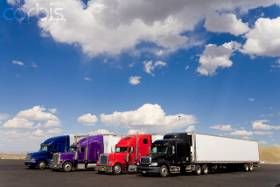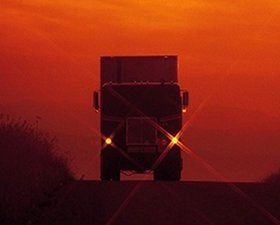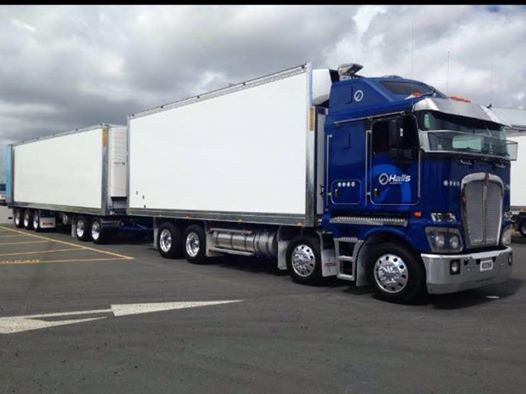Video Shows Semi Blown Over By Wind On Idaho Bridge
Topic 3095 | Page 1
Yikes. It seems there are a million ways out there to have your life in danger in this career.

That plain sucks all around.
Dave

What could/should the driver had done, if anything??
Stephen E. Birch

Since it was a wind GUST, there is nothing that the driver could have done.... I'd say that its one more reason to pull a flatbed....but I've seen the tandems of our flatbed (empty) lifted off the pavement, when the wind got under it...not fun.....
Tandems:
Tandem Axles
A set of axles spaced close together, legally defined as more than 40 and less than 96 inches apart by the USDOT. Drivers tend to refer to the tandem axles on their trailer as just "tandems". You might hear a driver say, "I'm 400 pounds overweight on my tandems", referring to his trailer tandems, not his tractor tandems. Tractor tandems are generally just referred to as "drives" which is short for "drive axles".
Tandem:
Tandem Axles
A set of axles spaced close together, legally defined as more than 40 and less than 96 inches apart by the USDOT. Drivers tend to refer to the tandem axles on their trailer as just "tandems". You might hear a driver say, "I'm 400 pounds overweight on my tandems", referring to his trailer tandems, not his tractor tandems. Tractor tandems are generally just referred to as "drives" which is short for "drive axles".

What could/should the driver had done, if anything??
Stephen E. Birch
They shut the interstate down that same day. They had 2 other tractor trailers blow over as well. They had reports of wind speeds reaching 60mph. Hopefully you will see or hear something about a wind advisory. Usually the DOT puts out some kind of message. If you are empty or light you pull over because it is unsafe to drive.
DOT:
Department Of Transportation
A department of the federal executive branch responsible for the national highways and for railroad and airline safety. It also manages Amtrak, the national railroad system, and the Coast Guard.
State and Federal DOT Officers are responsible for commercial vehicle enforcement. "The truck police" you could call them.
Interstate:
Commercial trade, business, movement of goods or money, or transportation from one state to another, regulated by the Federal Department Of Transportation (DOT).
What I used to do in real heavy crosswinds like that is start by getting as far as I could to the upwind side and try desperately to make sure nobody was near me, especially alongside me. In his case that would have wanted to be as far as he can get to the right. I'd run a little slower than usual and make sure I had my cruise control off and my foot was holding it at 1/2 throttle or less if possible. Then if a big gust hit you let the truck drift with the wind as much as you can, depending on how much room you have available on your downwind side. Hopefully a full lane or more. During that gust you watch for that trailer to begin to lift. If it does, what you want to do is to mash the gas to the floor and keep letting it drift downwind or even steer it downwind a bit if you have the room. Use all the room you have.
The combined forces of mashing the gas and drifting with the wind will help keep those trailer tires on the roadway. A gust usually only last a few seconds. You can see in that video that the trailer came up once and came back down. Then it came up again and balanced for what seemed like forever right on the tipping point before finally going over. If there would have been any way he could have just counteracted that tipping force a tiny bit it might have come back down.
It's impossible to see from that video how much room he had to work with or if there was anything more he could have done. Maybe he did steer with it the first time and that's what brought the trailer back down. But I know when the trailer rolled it didn't land on a divider or anything and I didn't see any vehicles coming from the other direction so it seems he may have had more room to work with. Was he watching his mirrors? Was he drifting with the wind? Did he use all the room he had available? It's very hard to say for sure. But as any experienced driver will tell you, there will be times you will come within a few seconds or a few feet of having a major catastrophe. Just the right reaction at just the right time will make all the difference. In this case he may have been able to save it, maybe not. I don't know.
But this is another example of a catastrophic disaster on a beautiful sunny day in light traffic, which you may have heard me say is when most of the worst accidents I've ever come across have happened. It's not always during snowstorms or thunderstorms or in rush hour traffic that you tend to see the "big ones" happen. It's on those relaxing days when it's easy to let your guard down for a moment.
HOS:
Hours Of Service
HOS refers to the logbook hours of service regulations.
I'll tell you one thing, speaking of wind, I'm definitely not looking forward to possibly getting caught in or anywhere nearby a tornado. It's probably my biggest fear of driving - not that I obsess about this. I was caught near two simultaneous tornadoes driving through Nebraska about 15 years ago. Nowhere for cover - no place to hide. Flat and WIDE OPEN. No buildings nearby. Best possible scenario would've been parking the car and finding a ditch. Yeah right. All we could do was turn in what appeared to be the opposite direction and pray that they wouldn't change course or catch up. Yeah, you're never supposed to try and outrun a tornado... Not sure if I'll have to drive in tornado alley at all with my NE location, but it's definitely a concern of mine! Wind gusts are scary, torrential rain, ice - but tornadoes for me are like the great white sharks of weather. I love them and are scared to death of them!

Being a California boy, I'll take earthquakes over just about any of the destructive weather out there - tornados, hurricanes, etc. When the earthquake strikes, it is pretty instantaneous and you're either at ground "zero" or you're not. I've been around almost all of the really devastating modern shakers here in California and for the most part, you escape any real consequences . . . lots of busted stuff afterwards but given how many people COULD have been killed, hurt, etc. it is pretty surprising how few are directly affected . . .
Stephen E. Birch

Now when the BIG ONE hits (and it will) there is no good place to be . . .


Now when the BIG ONE hits (and it will) there is no good place to be . . .
True bro!
Down here we're on the Ring of Fire just like Cali. There is a major fault line running right Under my mothers farm, major enough and overdue enough that there are sensors from the Uni of Tokyo spread around the faultline, including one on mums farm itself.
You are better off in a timber and nails home than any Architectural whizz kid design of concrete and glass.
LTL:
Less Than Truckload
Refers to carriers that make a lot of smaller pickups and deliveries for multiple customers as opposed to hauling one big load of freight for one customer. This type of hauling is normally done by companies with terminals scattered throughout the country where freight is sorted before being moved on to its destination.
LTL carriers include:
- FedEx Freight
- Con-way
- YRC Freight
- UPS
- Old Dominion
- Estes
- Yellow-Roadway
- ABF Freight
- R+L Carrier
New Reply:
New! Check out our help videos for a better understanding of our forum features

















Preview:
This topic has the following tags:
Safe Driving Tips







 TT On Facebook
TT On Facebook
Video shows semi blown over by wind on Idaho bridge
Video courtesty Cody Goodnight shows a semi-truck blown over by a high wind gust on the Hansen Bridge Monday.